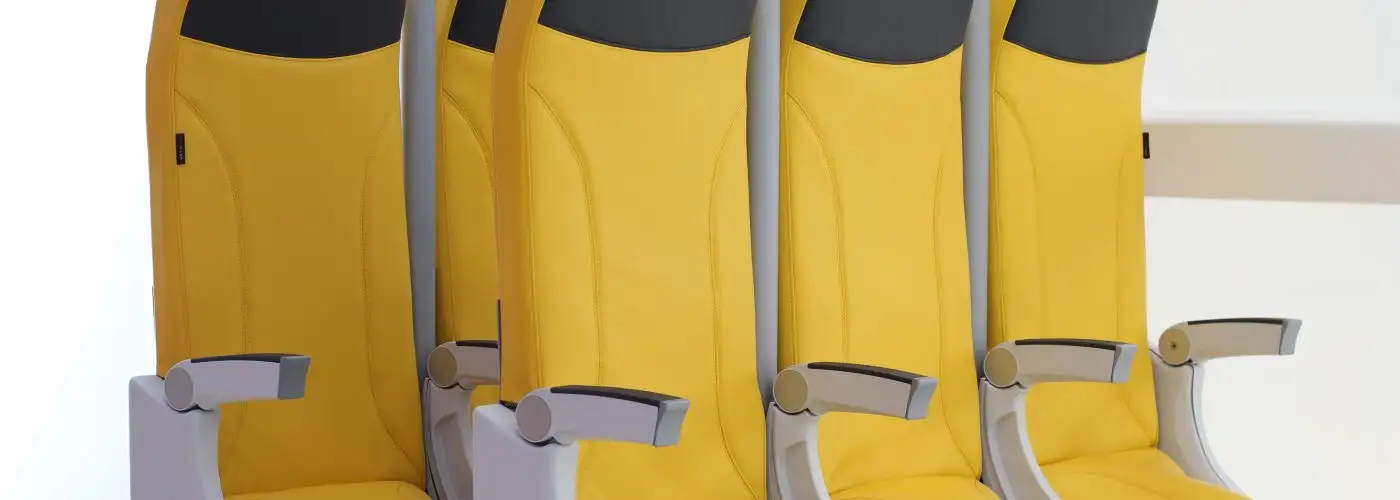Eight years ago, seat maker Avio showed off an airline “seat” that supported passengers but didn’t really seat them. Instead, passengers would lean against a padded backrest and tiled semi-seat attached to a vertical pole, but they’d still support some weight on their feet. Dubbed the Skyrider, the seat would allow passenger rows with a front-to-rear spacing, or pitch, as low as 23 inches, compared with the minimum of 29 inches for today’s worst economy cabins and 30-31 inches for most giant lines.
The benefit to airlines? More passengers in each plane. The advantage to passengers? Lower fares. The original announcement was greeted with much derision and amusement, from both consumer and industry sources, with lots of jokes—but no long-term interest.
Now, in 2018, Avio is back with Skyrider 2.0, again showing off at the Airliners Interiors Expo in Hamburg what it claims is an “improved” product. And the business is again buzzing with both “why” and “why not” questions.
Why Standing Airline Seats Might Work
Low fares are now irresistible. Air travelers have already demonstrated their willingness to accept a really terrible seating product if fares are low enough, and Skyrider doesn’t look a lot worse than what you get today on bottom-feeding airlines. At least it’s better than the unsupported standing room that many big-city rail commuters face every day? At low enough fares, Skyrider might well attract a sizable market for short-haul flights of maybe an hour or hour and a half or so.
Why Standing Airline Seats Might Not Work
Safety issues are a challenge. The number of passengers a commercial plane can hold is limited by the ratio of passengers to exit doors, and today’s jets are already at or close to those limits. In addition, it’s hard to see how the design could pass the 16G impact requirement of today’s seating. Also, Skyrider would probably be limited to relatively short flights, and airlines could install it in only a small dedicated fleet of very-short-haul planes that couldn’t be used elsewhere—a big problem for most airlines.
What Happens Next
Industry mavens can and will debate the pros and cons of Skyrider for years, but a true test would be definitive. Could Avio get a low-fare airline to install Skyrider in one test plane and see how the real-world market reacts? Interesting, but unlikely.
I’d put the chances of actual Skyrider installations at less than 50 percent. If any, the first installations will likely be in Asia or Europe. Still, as often noted in the airline business, nothing catches on as fast as a bad idea.
More from SmarterTravel:
- The Safest Seat on the Plane
- Should Airlines Get Rid of Reclining Seats? This One Is
- Air Passenger Rights: The on-the-Go Guide
Consumer advocate Ed Perkins has been writing about travel for more than three decades. The founding editor of the Consumer Reports Travel Letter, he continues to inform travelers and fight consumer abuses every day at SmarterTravel.
We hand-pick everything we recommend and select items through testing and reviews. Some products are sent to us free of charge with no incentive to offer a favorable review. We offer our unbiased opinions and do not accept compensation to review products. All items are in stock and prices are accurate at the time of publication. If you buy something through our links, we may earn a commission.
Related
Top Fares From
Today's Top Travel Deals
Brought to you by ShermansTravel
Shop and Save with Country Inns...
Patricia Magaña
 Hotel & Lodging Deals
Hotel & Lodging Deals
$229 -- Chicago: Discounted Rates and...
Francesca Miele
 Hotel & Lodging Deals
$229+
Hotel & Lodging Deals
$229+
$188 -- Honolulu: Save on Oceanview...
Abigail Lamay
 Hotel & Lodging Deals
$188+
Hotel & Lodging Deals
$188+




